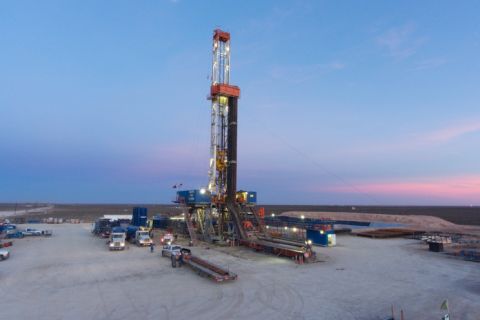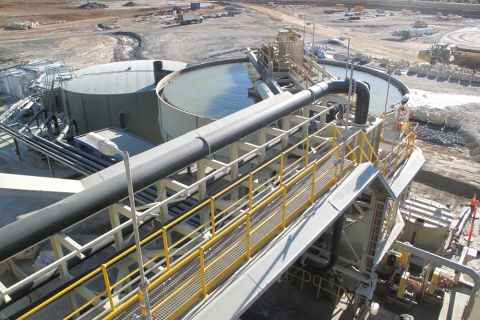
The new frontier for the unconventional gas technology is in old oil fields. This is a huge opportunity for using long laterals, multiple-stage fracs and smaller, high-tech fractures, said George King, global technology consultant, at the NAPE Business Conference on Feb. 22 in Houston.
“Right now, we have two big oil plays -- the Bakken and Eagle Ford. What if you take the name shale off of it? There are three or four more big plays coming on if you look at how many types of oil sandstones that could benefit from horizontal wells, multiple-stage fracturing and other technologies,” he explained.
“It is not just shales any more. I’ve been involved in drilling horizontal wells into water-flooded reservoirs that are 30 years old and never produced more than 20 to 25 barrels per day (b/d) per vertical well. The first couple of wells were drilled between the pattern. They were drilling along the fracture direction. There were five little longitudinal fracs along the well bore. They brought on a couple of wells that were over 300 b/d.
“If you’ve got some old reservoirs like that, start looking at them,” King emphasized.
Today’s huge increase in unconventional oil and gas production is a result of applying technology and figuring out how to use it.
“I’ve been told many times that the Barnett shale was a 17-year overnight success,” he laughed. “Take a look at recovery of original gas in place. It runs from 1% in the 1980s when that was all we thought we could get out of shale with the technologies at hand. In 2008, it was above 30% for the first time and above 45% in 2011.”
The same thing is beginning to happen in oil shales. “We are seeing recoveries of original oil in place starting to move. Recoveries have been at 1% and are now closing in on 5% to 8%. Do you see the pattern that is emerging here?” he asked.
“We saw it with natural gas. It took us 25 or 30 years to get to this point. We can do it faster with oil now that we have learned how to use many different technologies and adopt these technologies. We don’t know that much about oil shales. But, this is going to get better.
“The technologies we have applied haven’t been new,” he emphasized. “But, these technologies have been adopted and sharpened for specific shales, and that is the difference.”
On natural gas development, one example of how far the technology has been refined is in the expected ultimate recovery (EUR). “A good Barnett well might recover 2.0 billion cubic feet (Bcf) EUR. In some places like the Horn River Basin where Apache is operating, try 10 to 15 Bcf EUR. That is a result of applying technology and figuring out how to use it,” King explained.
Technology involves many things, including equipment, fit-for-purpose technology and application experience, and therefore people.
In the Horn River Basin, Apache applied fit-for-purpose technology in designing its well pads. The first pad the company used has 16 or 18 wells and 274 fracs, King said.
“We reshaped the next pad for the next year for 12 wells. We increased the stages and lengths. We came out ahead on drilling time, were under budget, were right at or ahead of schedule, and had a lot better production.
The company’s 34-L pad covers six acres and drains 6,000 acres. It can be reclaimed down to 1/3 acre. The wellheads are only 10 ft apart. The equipment was fit-for-purpose to allow fracturing of all the wells on a single pad, he noted.
Apache also moved away from fresh water for fracing the wells. Instead, the company tapped into a saltwater zone just above the shale. “We didn’t use saltwater before because the chemicals didn’t work. Now we have chemicals that work with saltwater,” he pointed out.
The saltwater is treated before going to the frac tanks. The fluid is pumped down the hole during fracturing. It is recovered back to the surface and treated before being pumped back into the saltwater zone. It is a closed-loop system that doesn’t use fresh water, King stated.
“It is not so much a factor of whether technology will or will not work, it is a question of timing,” he explained. “As technology is developed, many of these shales that are uneconomic now will become economic as we move along. The issue is about focusing on what technology to use and when to use it.”
Recommended Reading
APA’s Permian to Pick up Production Slack Amid Overseas Headaches
2024-02-26 - With various overseas headaches, Houston-based APA Corp. aims to boost its Permian Basin volumes and integrate its Callon Petroleum acquisition when it closes in the second quarter.
Repsol Eyes Increasing Core US Upstream Business
2024-02-29 - Madrid-based Repsol SA will invest €$2.2 billion (US$2.38 billion) between 2024-2027 on its unconventional assets in the Marcellus and Eagle Ford as it focuses on increasing its core U.S. upstream business platform.
Global Energy Watch: Corpus Christi Earns Designation as America's Top Energy Port
2024-02-06 - The Port of Corpus Christi began operations in 1926. Strategically located near major Texas oil and gas production, the port is now the U.S.’ largest energy export gateway, with the Permian Basin in particular a key beneficiary.
NAPE: In Basins Familiar to E&Ps, Lithium Rush Offers Little Gold
2024-02-07 - A quest for sources of lithium comes as the lucrative element is expected to play a part in global efforts to lower emissions, but in many areas the economics are challenging.
Everywhere All at Once: Woodside CEO Touts Current Global Portfolio
2024-03-05 - Meg O’Neill, the CEO of Australian energy giant Woodside Energy, is overseeing the “next wave” of growth projects around the globe, including developments in the Gulf of Mexico, offshore Senegal and further LNG expansion.





